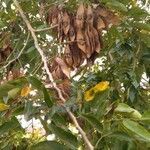Trees, 10-20 m tall. Bark dull gray; young shoots pale green, glabrous. Leaves 15-25 cm; leaflets 7-11, elliptic to oblong-elliptic, 3.5-6 × 2.5-4 cm, subleathery, both surfaces glabrous, shiny adaxially, veinlets prominent, base rounded or broadly cuneate, apex obtuse or slightly emarginate. Panicles terminal or extending into axils of uppermost leaves, 15-20 × 10-20 cm, sparsely rusty puberulent. Flowers 6-7 mm. Pedicel ca. 5 mm, sparsely rusty puberulent as calyx; bracts and bracteoles deciduous, ovate, pubescent. Calyx campanulate, 2-3 mm, 5-toothed; upper pair of teeth rounded, subconnate, lateral 2 smaller, ovate, lowest tooth lanceolate, ca. 2 × as long as others. Corolla white or light purple; petals clawed; standard orbicular, emarginate; wings obovate and half-moon-shaped; keel auriculate on upper side below. Stamens 10, diadelphous (5+5). Ovary shortly stipitate, glabrous except at base and stipe, 2-or 3-ovuled; style slender; stigma capitate, small. Legume oblong or broadly ligulate, 4-7 × 1.3-1.5 cm, thinly leathery, reticulate opposite 1 or 2(or 3) seeds, base attenuate to stipe, apex acute. Seeds reniform, 7-14 × 5-9 mm. Fl. May-Jul.
More
A tree. It grows up to 20 m tall. The trunk is 50 cm across. The young shoots are pale green. The leaves are 15-25 cm long. There are 7-11 leaflets. These are 4-6 cm long by 3-4 cm wide. The flower panicles are 15-20 cm long by 10-20 cm wide. The flowers are 6-7 mm across. The pod is 4-7 cm long by 1-2 cm wide. There are 1 to 2 kidney shaped seeds.
Sunny wild uplands. In forests or among bushes on mountain slope, ravines by streams and woodland slopes; at elevations from 800-1,400 metres.
More
A tropical plant. It grows from 800-1400 m altitude in Southern China. Mt Cootha Botanical Gardens. In Sichuan and Yunnan.
Can be grown by seedlings. Seeds needs soaking.


